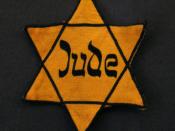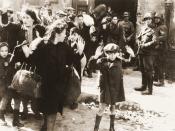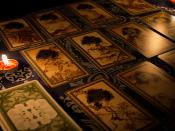A Scrap of Time is an eye-opening novel about life in Poland during World War II. It is based on true experiences that tells the heart-wrenching stories of many Jewish people. These stories are only few of many that are still waiting to be told.
"A Dog"ÃÂ disheartened me and brought tears to my eyes. Ching was a mix bread dog who was very loyal to his Jewish owners, but he also adored the housemaid, Agata. Ching's family was forced into the ghetto, but managed to escape. Agata hid them in a small shelter at her new country home. The SS soldiers were searching for the family and came upon their dog. They said, "Go find your owners."ÃÂ Ching would not budge; he wouldn't betray his loyalty to his family. This enraged the SS officer, so he found Ching a few days later and hung him in Agata's front yard.
The officer's excuse was the Jewish dogs even sicken him. Ching died a hero and with honor (even though he was a dog). He died for the sake of his owner's lives.
"The Shelter"ÃÂ was a compelling piece of writing, which proved the power of a helping hand. It told the tale of a Jewish man and woman, who were hidden in a Gentile home. They were confined to one tiny room behind a wall. The ironic twist to this situation was the Gentile family also was quartering Nazi soldiers. They survived with Nazis, literally, breathing down their necks. The Gentile family risked everything, including their lives, to help this couple. They wouldn't let evil overcome their morals.
Many times when parents knew the Nazis were coming, they hid their children or tried to the best they could by hiding them. In "A Spring Morning"ÃÂ a family of three (a mom, dad and a 5 year-old daughter) waited patiently for the SS men to capture them and send them to die. When the Nazis came to their home, they went in peace. The father could not bear to see his child loose her life at five, so instead of insisting that she walk with them, he set her in a congregation of Church-goers. As the child was diligently running away, the father heard a single shot, and soon found his dead child lying in the street. The father was forced to carry his dead daughter all the way to the fields where he faced his murder.
Parents also prepared their children for what may come. In "The Key Game"ÃÂ, the parents of a three year-old boy teach him what to do if the SS men were to knock on the door when his mother is away at work. He was to take lots of time to find the keys to open the front door, so his Jewish father could hide under the bathtub. The child was forced to say (if asked) that his father was dead. Children of the Holocaust didn't have the right to live because they were not necessary for the war efforts, so they were put to death. In "Traces"ÃÂ a Holocaust survivor tells the story of the eight children that were murdered in "the butcher shop ghetto"ÃÂ. She recalls the children being brought down from the Judenrat's attic, where they were hiding. They were asked by the SS man to point out their parents, but they refused. "They sat there motionless and looked straight ahead."ÃÂ In the photograph the survivor was looking at, she could see the little footprints left behind in the snow. All the children were dragged to a field and shot to death.
People would do almost anything for Aryan papers, including the sixteen year-old girl in "Aryan Papers"ÃÂ. Her and her mother got their previous papers taken away and were in desperate need of new ones. They girl knew a man who could her papers for her, but only for a price. She had to give him money, and give him herself. She had nothing else to give, so she slept with a man she hardly knew to save her and her mother's lives.
The few Jews that did survive HAD to go back home or what they had left of a home. "The Tenth Man"ÃÂ depicts people coming home to destruction. The first man that came home saw his hundred year-old synagogue burnt to ashes. When he came back his front door was nailed shut, so he sat on his front porch and stared with a blank look for more than four days.
Next, a tenant farmer came back to this town. When he arrived he fell flat to the ground kissing the threshold of his house, thanking God for saving him. After this three more men came back and for three days they lay on their floor by the door, sleeping. The neighbors heard them screaming from their horror filled dreams at night.
After them the teacher's wife returned. As she reached her home she burst out sobbing. Ten people some back to discover hell again. And one of the merchants stood by the railroad tracks each day waiting for his wife to return home- which would never happen.
Jews did anything they could to save their precious lives. They helped, hoped, lost, and few won. There are so many stories that are left untold, so many stories that need to be released. People need to see the pain and the harsh reality of the Holocaust.
A Scrap of Time is one of many contributions to the Holocaust. This novel shows the true stories, sometimes in the writer's own voice. A Scrap of Time shows what went on in Poland during the time of World War II. It gives real accounts on what happened. It lets survivors and victims get their voices out; it lets them tell their stories.
A Scrap of Time is an award-winning novel, which has had much recognition. In 1987, it won the ALA Notable Book, the Anne Frank Prize, the New York Times Book Review Notable Book, ALA Best Book, and it is the winner of the PEN/Book-of-the-Month Club Translation prize.
A Scrap of Time reveals secrets of the past. It has whispers of the innocent. It has forced people to what went on and how the Jews had to risk everything just to survive. It shows that without will and endurance none of the survivors would be living and sharing their experiences with the rest of the world. Without novels like these, the world would never know what really went on. We would only have documents that proved cruelties, but we would never know how these people felt. We would never be able to see into the people's souls and be right there with them in time of desperation and loneliness. This novel puts real people into our heads, people that think, feel, and live. They are not just a number or a photograph, but they are living beings that suffered.




